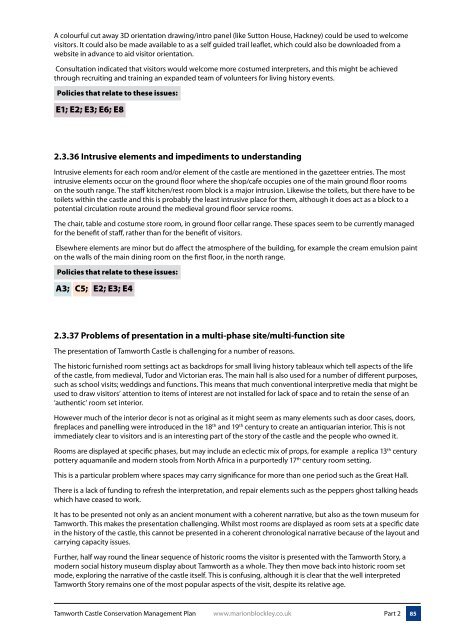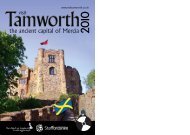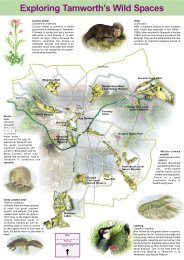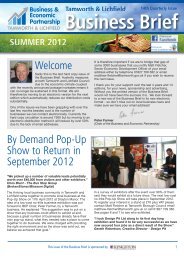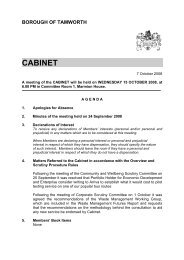Conservation Management Plan - Tamworth Borough Council
Conservation Management Plan - Tamworth Borough Council
Conservation Management Plan - Tamworth Borough Council
Create successful ePaper yourself
Turn your PDF publications into a flip-book with our unique Google optimized e-Paper software.
A colourful cut away 3D orientation drawing/intro panel (like Sutton House, Hackney) could be used to welcome<br />
visitors. It could also be made available to as a self guided trail leaflet, which could also be downloaded from a<br />
website in advance to aid visitor orientation.<br />
Consultation indicated that visitors would welcome more costumed interpreters, and this might be achieved<br />
through recruiting and training an expanded team of volunteers for living history events.<br />
Policies that relate to these issues:<br />
E1; E2; E3; E6; E8<br />
2.3.36 Intrusive elements and impediments to understanding<br />
Intrusive elements for each room and/or element of the castle are mentioned in the gazetteer entries. The most<br />
intrusive elements occur on the ground floor where the shop/cafe occupies one of the main ground floor rooms<br />
on the south range. The staff kitchen/rest room block is a major intrusion. Likewise the toilets, but there have to be<br />
toilets within the castle and this is probably the least intrusive place for them, although it does act as a block to a<br />
potential circulation route around the medieval ground floor service rooms.<br />
The chair, table and costume store room, in ground floor cellar range. These spaces seem to be currently managed<br />
for the benefit of staff, rather than for the benefit of visitors.<br />
Elsewhere elements are minor but do affect the atmosphere of the building, for example the cream emulsion paint<br />
on the walls of the main dining room on the first floor, in the north range.<br />
Policies that relate to these issues:<br />
A3; C5; E2; E3; E4<br />
2.3.37 Problems of presentation in a multi-phase site/multi-function site<br />
The presentation of <strong>Tamworth</strong> Castle is challenging for a number of reasons.<br />
The historic furnished room settings act as backdrops for small living history tableaux which tell aspects of the life<br />
of the castle, from medieval, Tudor and Victorian eras. The main hall is also used for a number of different purposes,<br />
such as school visits; weddings and functions. This means that much conventional interpretive media that might be<br />
used to draw visitors’ attention to items of interest are not installed for lack of space and to retain the sense of an<br />
‘authentic’ room set interior.<br />
However much of the interior decor is not as original as it might seem as many elements such as door cases, doors,<br />
fireplaces and panelling were introduced in the 18 th and 19 th century to create an antiquarian interior. This is not<br />
immediately clear to visitors and is an interesting part of the story of the castle and the people who owned it.<br />
Rooms are displayed at specific phases, but may include an eclectic mix of props, for example a replica 13 th century<br />
pottery aquamanile and modern stools from North Africa in a purportedly 17 th century room setting.<br />
This is a particular problem where spaces may carry significance for more than one period such as the Great Hall.<br />
There is a lack of funding to refresh the interpretation, and repair elements such as the peppers ghost talking heads<br />
which have ceased to work.<br />
It has to be presented not only as an ancient monument with a coherent narrative, but also as the town museum for<br />
<strong>Tamworth</strong>. This makes the presentation challenging. Whilst most rooms are displayed as room sets at a specific date<br />
in the history of the castle, this cannot be presented in a coherent chronological narrative because of the layout and<br />
carrying capacity issues.<br />
Further, half way round the linear sequence of historic rooms the visitor is presented with the <strong>Tamworth</strong> Story, a<br />
modern social history museum display about <strong>Tamworth</strong> as a whole. They then move back into historic room set<br />
mode, exploring the narrative of the castle itself. This is confusing, although it is clear that the well interpreted<br />
<strong>Tamworth</strong> Story remains one of the most popular aspects of the visit, despite its relative age.<br />
<strong>Tamworth</strong> Castle <strong>Conservation</strong> <strong>Management</strong> <strong>Plan</strong> www.marionblockley.co.uk<br />
Part 2<br />
85


